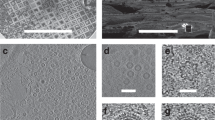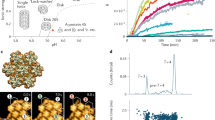Abstract
The capsid of the herpes simplex virus initially assembles as a procapsid that matures through a massive conformational change of its 182 MDa surface shell. This transition, which stabilizes the fragile procapsid, is facilitated by the viral protease that releases the interaction between the shell and the underlying scaffold; however, protease-deficient procapsids mature slowly in vitro. To study procapsid maturation as a time-resolved process, we monitored this reaction by cryo-electron microscopy (cryo-EM). The resulting images were sorted into 17 distinct classes, and three-dimensional density maps were calculated for each. When arranged in a chronological series, these maps yielded molecular movies of procapsid maturation. A single major switching event takes place at stages 8–9, preceded by relatively subtle adjustments in the pattern of interactions and followed by similarly small 'aftershocks'. The primary mechanism underlying maturation is relative rotations of domains of VP5, the major capsid protein.
This is a preview of subscription content, access via your institution
Access options
Subscribe to this journal
Receive 12 print issues and online access
$189.00 per year
only $15.75 per issue
Buy this article
- Purchase on Springer Link
- Instant access to full article PDF
Prices may be subject to local taxes which are calculated during checkout







Similar content being viewed by others
References
Newcomb, W.W. et al. Assembly of the herpes simplex virus capsid: characterization of intermediates observed during cell-free capsid formation. J. Mol. Biol. 263, 432–446 (1996).
Trus, B.L. et al. The herpes simplex virus procapsid: structure, conformational changes upon maturation, and roles of the triplex proteins VP19c and VP23 in assembly. J. Mol. Biol. 263, 447–462 (1996).
Steven, A.C., Couture, E., Aebi, U. & Showe, M.K. Structure of T4 polyheads. II. A pathway of polyhead transformation as a model for T4 capsid maturation. J. Mol. Biol. 106, 187–221 (1976).
Wurtz, M., Kistler, J. & Hohn, T. Surface structure of in vitro assembled bacteriophage-λ polyheads. J. Mol. Biol. 101, 39–56 (1976).
Canady, M.A., Tihova, M., Hanzlik, T.N., Johnson, J.E. & Yeager, M. Large conformational changes in the maturation of a simple RNA virus, Nudaurelia capensis omega virus (NomegaV). J. Mol. Biol. 299, 573–584 (2000).
Turner, B.G. & Summers, M.F. Structural biology of HIV. J. Mol. Biol. 285, 1–32 (1999).
Duda, R.L. et al. Structural transitions during bacteriophage HK97 head assembly. J. Mol. Biol. 247, 618–635 (1995).
Dokland, T. & Murialdo, H. Structural transitions during maturation of bacteriophage-λ capsids. J. Mol. Biol. 233, 682–694 (1993).
Prasad, B.V.V. et al. Three-dimensional transformation of capsids associated with genome packaging in a bacterial virus. J. Mol. Biol. 231, 65–74 (1993).
Conway, J.F., Duda, R.L., Cheng, N., Hendrix, R.W. & Steven, A.C. Proteolytic and conformational control of virus capsid maturation: the bacteriophage HK97 system. J. Mol. Biol. 253, 86–99 (1995).
Butcher, S.J., Dokland, T., Ojala, P.M., Bamford, D.H. & Fuller, S.D. Intermediates in the assembly pathway of the double-stranded RNA virus φ6. EMBO J. 16, 4477–4487 (1997).
Tao, Y. et al. Assembly of a tailed bacterial virus and its genome release studied in three dimensions. Cell 95, 431–437 (1998).
Cerritelli, M.E., Conway, J.F., Cheng, N., Trus, B.L. & Steven, A.C. Molecular mechanisms in bacteriophage T7 assembly, maturation and DNA containment. Adv. Prot. Chem., in the press.
Cheng, N. et al. Handedness of the herpes simplex virus capsid and procapsid. J. Virol. 76, 7855–7859 (2002).
Onorato, L., Stirmer, B. & Showe, M.K. Isolation and characterization of bacteriophage T4 mutant preheads. J. Virol. 27, 409–426 (1978).
Ross, P.D., Black, L.W., Bisher, M.E. & Steven, A.C. Assembly-dependent conformational changes in a viral capsid protein. Calorimetric comparison of successive conformational states of the gp23 surface lattice of bacteriophage T4. J. Mol. Biol. 183, 353–364 (1985).
Galisteo, M.L. & King, J. Conformational transformations in the protein lattice of phage P22 procapsids. Biophys. J. 65, 227–235 (1993).
Conway, J.F. et al. Virus maturation involving large subunit rotations and local refolding. Science 292, 744–748 (2001).
Newcomb, W.W. et al. Structure of the herpes simplex virus capsid: molecular composition of the pentons and triplexes. J. Mol. Biol. 232, 499–511 (1993).
Lata, R. et al. Maturation dynamics of a viral capsid: visualization of transitional intermediate states. Cell 100, 253–63 (2000).
Gao, M. et al. The protease of herpes simplex virus type 1 is essential for functional capsid formation and viral growth. J. Virol. 68, 3702–3712 (1994).
Newcomb, W.W. et al. Isolation of herpes simplex virus procapsids from cells infected with a protease-deficient mutant virus. J. Virol. 74, 1663–1673 (2000).
Trus, B.L. et al. Herpes simplex virus capsids assembled in insect cells infected with recombinant baculoviruses: structural authenticity and localization of VP26. J. Virol. 69, 7362–7366 (1995).
Newcomb, W.W. et al. Assembly of the herpes simplex virus procapsid from purified components and identification of small complexes containing the major capsid and scaffolding proteins. J. Virol. 73, 4239–4250 (1999).
Rixon, F.J. & McNab, D. Packaging-competent capsids of a herpes simplex virus temperature-sensitive mutant have properties similar to those of in vitro-assembled procapsids. J. Virol. 73, 5714–5721 (1999).
King, J. & Chiu, W. The procapsid-to-capsid transition in double-stranded DNA bacteriophages. in Structural Biology of Viruses (eds. Chiu, W., Burnett, R.M. & Garcea, R.) 288–311 (Oxford University Press, New York, 1997).
Saibil, H.R. Conformational changes studied by cryo-electron microscopy. Nat. Struct. Biol. 7, 711–714 (2000).
Berriman, J. & Unwin, N. Analysis of transient structures by cryo-microscopy combined with rapid mixing of spray droplets. Ultramicroscopy 56, 241–252 (1994).
Walker, M., Trinick, J. & White, H. Millisecond time resolution electron cryo-microscopy of the Mg-ATP transient kinetic state of the acto-myosin ATPase. Biophys. J. 68, 87S–91S (1995).
Rixon, F.J., Cross, A.M., Addison, C. & Preston, V.G. The products of herpes simplex virus type 1 gene UL26 which are involved in DNA packaging are strongly associated with empty but not with full capsids. J. Gen. Virol. 69, 2879–2891 (1988).
Gibson, W., Marcy, A.I., Comolli, J.C. & Lee, J. Identification of precursor to cytomegalovirus capsid assembly protein and evidence that processing results in loss of its carboxy-terminal end. J. Virol. 64, 1241–1249 (1990).
Liu, F. & Roizman, B. Characterization of the protease and other products of amino-terminus-proximal cleavage of the herpes simplex virus 1 UL26 protein. J. Virol. 67, 1300–1309 (1993).
Morse, P.M. Thermal Physics (W.W. Benjamin, New York; 1964).
Steven, A.C. & Carrascosa, J.L. Proteolytic cleavage and structural transformation: their relationship in bacteriophage T4 capsid maturation. J. Supramol. Struct. 10, 1–11 (1979).
He, J., Schmid, M.F., Zhou, Z.H., Rixon, F. & Chiu, W. Finding and using local symmetry in identifying lower domain movements in hexon subunits of the herpes simplex virus type 1 B capsid. J. Mol. Biol. 309, 903–914 (2001).
Jontes, J.D., Wilson-Kubalek, E.M. & Milligan, R.A. A 32 degree tail swing in brush border myosin I on ADP release [see comments]. Nature 378, 751–753 (1995).
Roseman, A.M., Chen, S., White, H., Braig, K. & Saibil, H.R. The chaperonin ATPase cycle: mechanism of allosteric switching and movements of substrate-binding domains in GroEL. Cell 87, 241–252 (1996).
Conway, J.F. et al. The effects of radiation damage on the structure of frozen hydrated HSV-1 capsids. J. Struct. Biol. 111, 222–233 (1993).
Trus, B.L., Kocsis, E., Conway, J.F. & Steven, A.C. Digital image processing of electron micrographs: the PIC system-III. J. Struct. Biol. 116, 61–67 (1996).
Heymann, J.B. Bsoft: image and molecular processing in electron microscopy. J. Struct. Biol. 133, 156–169 (2001).
Baker, T.S. & Cheng, R.H. A model-based approach for determining orientations of biological macromolecules imaged by cryoelectron microscopy. J. Struct. Biol. 116, 120–130 (1996).
Steven, A.C. et al. Hexavalent capsomers of herpes simplex virus type 2: symmetry, shape, dimensions, and oligomeric status. J. Virol. 57, 578–584 (1986).
Zhou, Z.H., Prasad, B.V.V., Jakana, J., Rixon, F.J. & Chiu, W. Protein subunit structures in the herpes simplex virus capsid determined from 400-kV spot-scan electron cryomicroscopy. J. Mol. Biol. 242, 456–469 (1994).
Acknowledgements
We thank D. Belnap for programming contributions. This project was supported in part by the NIH Targeted Antiviral Program (A.C.S.). J.C.B. acknowledges grant support from the NIH and the NSF.
Author information
Authors and Affiliations
Corresponding author
Ethics declarations
Competing interests
The authors declare no competing financial interests.
Supplementary information
Supplementary Video 1
During the maturation process, the herpes simplex virus 1 precursor particle (procapsid) progresses through a succession of states from the naïve procapsid (state 1) to the fully mature capsid (state 17). The states were captured by cryo-EM and image reconstruction and are displayed here as time-lapse videos. The number (upper left) refers to the state. The particle is a T = 16 icosahedron, 1,250 Å in diameter. (MOV 3434 kb)
Video 1 shows the changes in the outer surface.
Supplementary Video 2
Video 2 shows the changes in the inner surface of the capsid viewed along a two-fold axis of symmetry. (MOV 4031 kb)
Supplementary Video 3
Video 3 is a close-up view of a portion of the inner surface. (MOV 3833 kb)
Supplementary Video 4
Video 4 is a close-up view of a portion the outer surface, centered on a peripentonal hexon (P-hexon). To its left is a penton, and to its right, an E-hexon (edge hexon). (MOV 3673 kb)
Supplementary Video 5
Video 5 shows a cutaway view through part of the surface shell, which is 150 Å thick. It sections through hexons and pentons of the major capsid protein and through the triplex complexes located at local three-fold symmetry axes. The inner scaffolding shell is not shown. (MOV 3081 kb)
Rights and permissions
About this article
Cite this article
Heymann, J., Cheng, N., Newcomb, W. et al. Dynamics of herpes simplex virus capsid maturation visualized by time-lapse cryo-electron microscopy. Nat Struct Mol Biol 10, 334–341 (2003). https://doi.org/10.1038/nsb922
Received:
Accepted:
Published:
Issue Date:
DOI: https://doi.org/10.1038/nsb922
This article is cited by
-
Cryo-electron microscopy structures of capsids and in situ portals of DNA-devoid capsids of human cytomegalovirus
Nature Communications (2023)
-
Structural transitions during the scaffolding-driven assembly of a viral capsid
Nature Communications (2019)
-
Protein interactions in the murine cytomegalovirus capsid revealed by cryoEM
Protein & Cell (2013)



